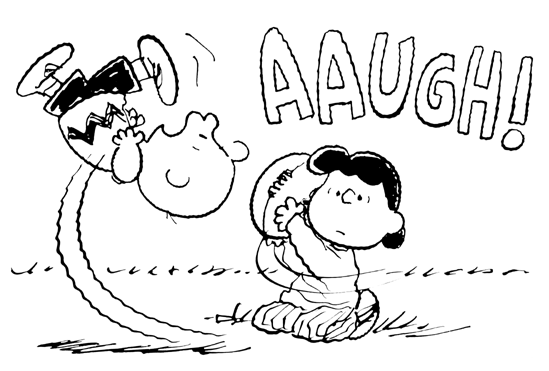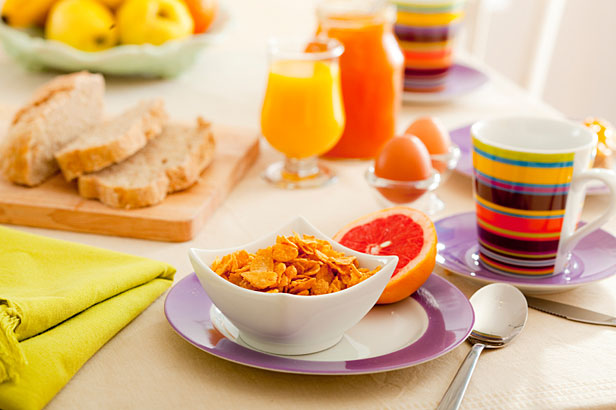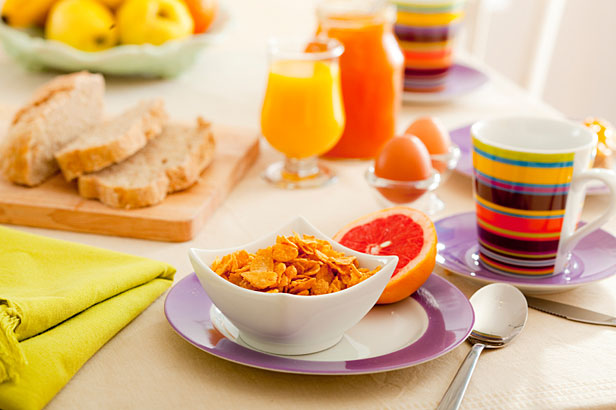 Breakfast of polyvore champions: The first meal of the day is likely to contain dozens of species.
Breakfast of polyvore champions: The first meal of the day is likely to contain dozens of species.
There is nothing more fundamental about our relationship with Nature than the species we eat.
One evening, while trying to discern exactly what was in the bean casserole my traveling wife had kindly left in the fridge, I wondered: What is the biodiversity of my diet? How many plant and animal species do I consume regularly? And where did they come from?
Later, I compiled a species list from one typical day for four meals: breakfast (cereal and toast), lunch (yogurt and a wrap), afternoon snack (cookie and tea), and dinner (scallops, broccoli, salad, and a brownie). Then, using food labels and knowledge of where I bought the food, I tracked down their origin and ecological niche. I looked up scientific names and kingdoms in the Integrated Taxonomic Information System. I knew where the local food came from, and for other items, where the food label did not specify the source, I determined foreign ones by knowledge of what does not grow in the U.S. (e.g., cacao) and presumed the rest were of U.S. origin.
I calculated that in 24 hours, I ate 53 species spanning four biological kingdoms and five continents.
If variety is the spice of life, we Homo sapiens are the spiciest of species. Our flexibility to change food sources and our ingenuity in finding and processing food has given us a broader diet than any other species. That allowed our ancestors to expand across almost the entire land area of Earth. We developed agriculture and ways of preserving and transporting food. We developed ways to process food sources that would otherwise be inedible. We have reached into almost every corner of Earth for food. Our technology and globalization have brought more species of food to more human societies than at any point in the 200,000 to 250,000 years our own species has been on the planet.
Our primitive ancestors knew very well as they battled the mastodon and gathered blueberries that, if successful, they would have roast mastodon smothered with blueberry sauce on the menu for supper. And later, in the days of Marco Polo, humans mostly ate locally, only getting a few items that traveled long distances by caravan or wind-powered ships.
We Homo sapiens could give more credence to the meaning of our self-given Latin name — “the wise hominid” — if we improved our awareness of what we eat. Are 17 species in one tablespoon of froufrou salad dressing needed to enjoy a fresh green salad?
Nowadays, not many people consider the pepper that squats on their dining table to be exotic, even though it traveled from foreign lands. Rarely do we think about what species comprise our plop-it-in-the-supermarket-cart food.
Here’s what it would look like if we did.
What species did I eat?
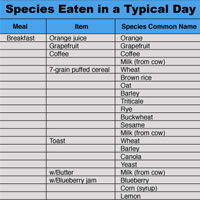 Click for full chartThe first table at right (click image for full version) lists the species I consumed by meal and ingredient. You can see that I was a vegetarian at breakfast, lunch, and afternoon snack; at dinner, an omnivore.
Click for full chartThe first table at right (click image for full version) lists the species I consumed by meal and ingredient. You can see that I was a vegetarian at breakfast, lunch, and afternoon snack; at dinner, an omnivore.
Numerically speaking, bacteria and yeast were undoubtedly the groups from which I ate the most individuals, so you could also call me a bacterian or yeastarian. By biomass or weight consumed, I am primarily a vegetarian.
But this article is about the number of distinct species consumed, not the number of individual organisms or the weight. The number of species shown is underestimated; it was not possible to identify all the species in some of the processed foods. It wasn’t clear from the food labels exactly what species produced the listed “citrus pectin” or “spices,” for example. Furthermore, I did not count the innumerable bacteria, viruses, protozoans, single-celled algae, slime molds, and other microbial species I ate unknowingly, although many of them provided me an essential service in my digestive tract. Nor did I keep track of any items that did not come from a living organism, such as salt.
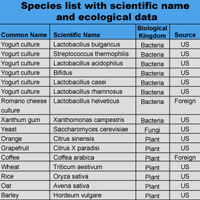 Click for full chartThe second table (left; click image for full version) lists the 53 species and the four biological Kingdoms from which they hailed. Note that wine and raisins both come from grapes (Vitis vinifera) and so get only one row in this table. Likewise, Capsicum annuum covers both green peppers and paprika.
Click for full chartThe second table (left; click image for full version) lists the 53 species and the four biological Kingdoms from which they hailed. Note that wine and raisins both come from grapes (Vitis vinifera) and so get only one row in this table. Likewise, Capsicum annuum covers both green peppers and paprika.
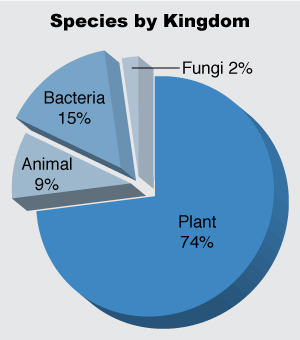 Several species appeared in more than one meal. Species I had at each meal included wheat, canola, and milk; I ate lemon and sugarcane at three of the four. I consumed the most biodiversity at dinner, 30 species, followed by lunch (23), breakfast (17), and afternoon snack (10). Three processed foods stood out for their high biodiversity: the cereal contained seven whole grains with sesame seeds thrown in for good measure; the no-fat yogurt containing six bacterial cultures had ten species; while the oil-and-vinegar salad dressing had enough species (17 plus) to form two baseball teams.
Several species appeared in more than one meal. Species I had at each meal included wheat, canola, and milk; I ate lemon and sugarcane at three of the four. I consumed the most biodiversity at dinner, 30 species, followed by lunch (23), breakfast (17), and afternoon snack (10). Three processed foods stood out for their high biodiversity: the cereal contained seven whole grains with sesame seeds thrown in for good measure; the no-fat yogurt containing six bacterial cultures had ten species; while the oil-and-vinegar salad dressing had enough species (17 plus) to form two baseball teams.
Primary producers of the plant kingdom contributed about 75 percent of the species — seven of these were trees (see pie chart, right). I took in more species of bacteria than of animals. Consumer species included herbivores (cows, honeybees), omnivores (chickens), and filter-feeders (sea scallops). This day, I did not consume any carnivores, detritus feeders, carrion-feeders, predators, or parasites — at least not to my knowledge!
Where did they come from?
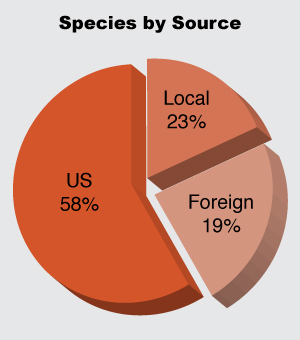 Most species were grown in the U.S. (see pie chart, left). About one-fifth of the species were local, meaning they came from within 100 miles, not that they were native. Only a handful of the species I consumed are native to Rhode Island, where I live, such as blueberry, raspberry, and sea scallop. Many cows, chickens, and lettuces call Rhode Island home, but they are not native.
Most species were grown in the U.S. (see pie chart, left). About one-fifth of the species were local, meaning they came from within 100 miles, not that they were native. Only a handful of the species I consumed are native to Rhode Island, where I live, such as blueberry, raspberry, and sea scallop. Many cows, chickens, and lettuces call Rhode Island home, but they are not native.
Ten species had been imported from other countries, such as olive (Italy), coffee (Columbia), and cacao (Ivory Coast). In general, the more local the food, the fewer the transportation miles, and the lower the daily food’s carbon footprint. However, according to Tyler Colman’s paper for the American Association of Wine Economists, when consumed in Rhode Island, a bottle of wine from France that comes by ship has a lower carbon footprint than one from California that comes by truck.
What happened to them before they got to me?
Many of the species (yogurt bacteria, fruits, vegetables) were alive when I ate them raw. Some food items embraced the entire individual (e.g., bac
teria, yeast); most were parts of organisms, such as fruits from orange trees, leaves from tea bushes, and muscles from scallops. Many of the fruits and vegetables had been harvested in ways that do not kill the individual tree or plant (e.g., oranges, tomatoes). Non-destructive means had been used for three of the food items from animals: milk from cows, eggs from chickens, and honey from bees.
Most of the species had been processed in some way before I encountered them — the puffing of the puffed grains in the cereal or the culturing of the cultured milk in the yogurt. Some of the foods I processed myself by cooking (scallops, rice, broccoli, brownies). Many of the species came packaged in paper or plastic bags, cardboard or plastic boxes, or glass or plastic bottles.
Plastic was pervasive. Even the organic purity of some of the unpackaged fruits and vegetables had been violated by little plastic stick-on labels. None of what I had this particular day came in a can.
What does it all mean?
We Homo sapiens could give more credence to the meaning of our self-given Latin name — “the wise hominid” — if we improved our awareness of what we eat.
Are 17 species in one tablespoon of froufrou salad dressing needed to enjoy a fresh green salad?
Eating should not be a contest to acquire the longest list of species, like some birder friends of mine who keep state lists, annual lists, and life lists of species spotted. With your food species, there’s no need to jump in your car and go to a restaurant a few towns away where a new species has appeared on the menu, no need to travel to foreign countries just to add a new life species.
On the other hand, humans evolved as an omnivorous species, with a wide food diet, well before we decided to get ourselves civilized and have an Industrial Revolution — and there’s no ecological need to give up that variety entirely. We benefit from a varied diet that provides a diverse range of nutrients. There’s no reason to cut back on the number of species we eat just for the sake of getting the numbers down. The point is to be more aware of how the species we eat were grown, and what happened to them before they got to us, so we can make wiser choices.
Those choices can help preserve the full range of Earth’s bountiful and beneficent biodiversity. We can buy food that is more local, fresh, and seasonable; choose food that is less processed, packaged, and advertised; decrease consumption of species grown or harvested by non-sustainable means; eat species lower on the food chain; and select foods that were grown with fewer commercial fertilizers, herbicides, pesticides, and fungicides.
A collection of species becomes a community when they interact to form something grander than their individual parts. Same with a good casserole. My wife’s bean casserole contained 12 species, and it was delicious.
Just as a good cook likes to present meals with complementary colors, smells, textures, and flavors, Nature left alone leads to ecological communities with a plenitude of complementary, interacting species — a natural casserole that we, for our own good, must sustain.
What species did you pluck today from the tree of life? What species do you have in your pantry and refrigerator? Where did they come from, and what happened to them before they got to you?
